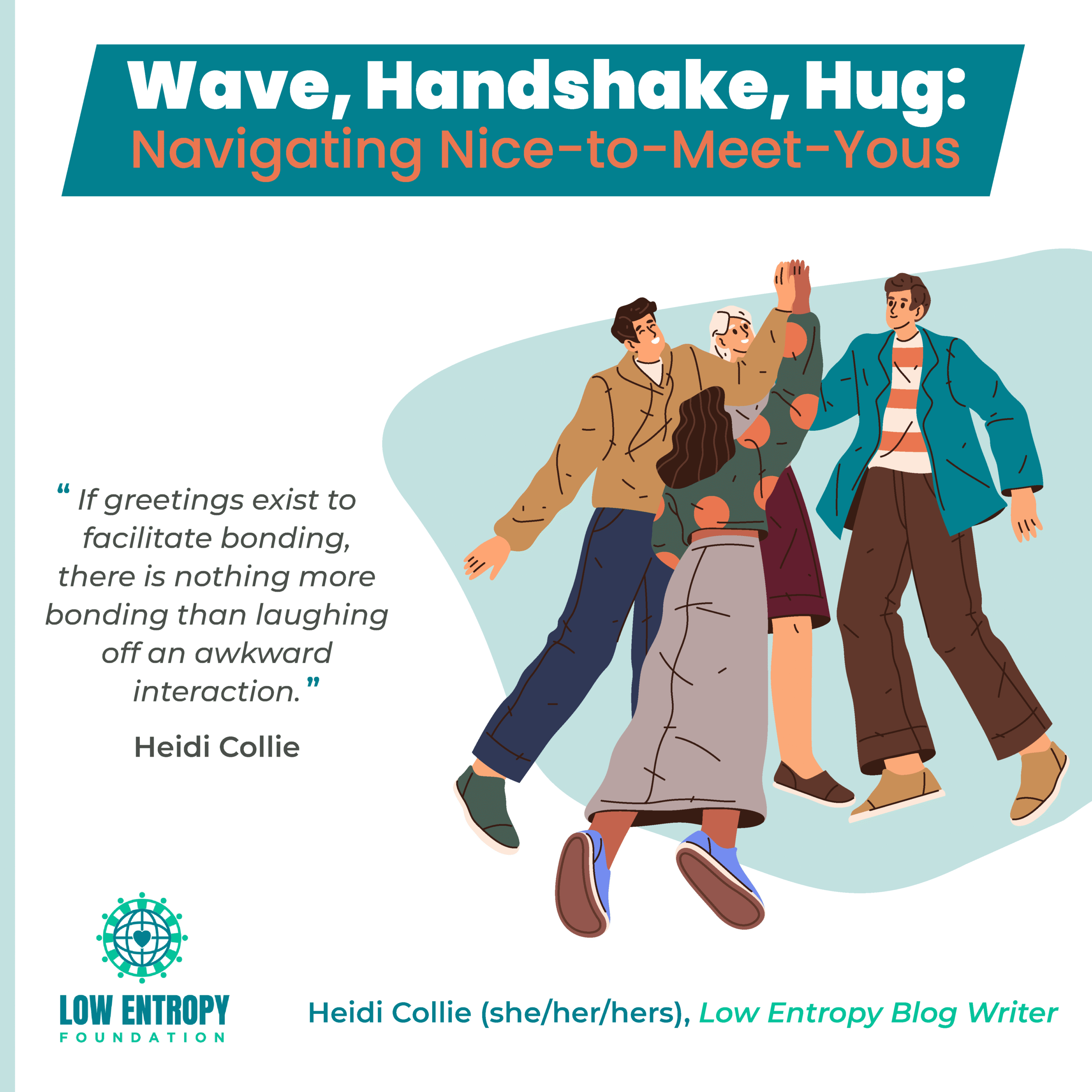Heidi Collie (she/her/hers), Low Entropy Blog Writer
Nice to meet you, how are you?
A few weeks ago I was chatting to two of my sisters and the conversation naturally turned to first impressions and styles of physical greeting. Even though most of us encounter this situation very regularly, I suspect you’ll never really pay attention to it until you’re caught between a rock (handshake) and a hard place (hug) and end up taking a step forward and waving. Try to think of something more mortifying because I promise it does not exist.
In that particular conversation, the consensus of three twentysomething British women was as follows: broadly speaking, if the person is approximately our own age, it’s a hug. If the person is female-presenting and not our age, it’s probably a hug (preferably initiated by them). If the person is not female-presenting and not our age, it’s a handshake. That is, unless any of this occurs in a formal environment, then it’s a handshake. We acknowledged (with admiration) how the Duchess of Cambridge attends functions with both hands clasped around a clutch bag at her front, preventing others from attempting a hug and leaving her in control of handshake initiation if she decides one is appropriate.
In order to fully understand the cultural significance of physical greetings, we should look to anthropological research. An article published by National Geographic last year draws from two perspectives: historical — that extending an empty hand to shake or wave demonstrates the absence of a concealed weapon — and biological — that touch is known to de-stress the body through the release of oxytocin. In his recent publication, Touch: The Science of the Sense That Makes Us Human, neuroscientist David J. Linden emphasizes the significance of touch as the first sense to become functional in utero and addresses how its centrality is increasingly appreciated in modern research.
In Friends: Understanding the Power of Our Most Important Relationships, anthropologist Robin Dunbar writes about the benefits of physical touch in the facilitation of long-standing social bonds. Modern humans tend to use methods of “virtual” grooming for group bonding (storytelling, ritual etc . . .) rather than frequent physical touch, but remnants of our evolutionary history endure. Ancient human behavior is believed to be mirrored by many contemporary non-human primates and Dunbar draws parallels with gelada baboons in the Ethiopian highlands, who spend up to 20% of their waking hours in physical contact, tending to the skin and fur of others. The effect is strong social bonds. Like physical touch, greetings often also involve a smile. According to Dunbar’s research, while human laughter derives from the monkey “play face,” smiling — such as that which you might force for a family photograph — comes from the monkey “submission face.” Perhaps baring your teeth to show you mean no harm is not so different from extending a hand to show you have no concealed weapon. Either way, it’s reassuring to know that our awkward styles of physical greeting are in fact crafted by the careful hands of evolution to serve the purpose of social bonding. It’s true that you never get a second chance to make a first impression, but with 200 million years of practice, maybe that’s ok.
The beauty of human psychology is in its complexity. It is not only the wave/handshake/hug decision that we must navigate, but the handshake-fistbump-backslap hybrid and the special pandemic elbow bump, and I can only assume that at some point women reach an age where they can’t help but kiss you on both cheeks. Anthropologically speaking, greetings are important for social bonding, but how, in a post-COVID world, can we get it 100% right 100% of the time? My answer is that we simply cannot. If greetings exist to facilitate bonding, there is nothing more bonding than laughing off an awkward interaction. Look out for boundaries that people might put up, but other than that, just try your best.
Put on that monkey submission face, make that judgment call. And to sum up — if you weren’t already overthinking it, you definitely are now.
—
Leave your thoughts for Heidi in the comments below. You can also follow us on Facebook, Instagram, TikTok, Twitter and YouTube to stay up-to-date with Low Entropy news!

